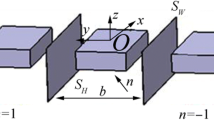Abstract
To solve the numerical divergence problem of the direct time domain Green function method for the motion simulation of floating bodies with large flare, a time domain hybrid Rankine-Green boundary element method is proposed. In this numerical method, the fluid domain is decomposed by an imaginary control surface, at which the continuous condition should be satisfied. Then the Rankine Green function is adopted in the inner domain. The transient free surface Green function is applied in the outer domain, which is used to find the relationship between the velocity potential and its normal derivative for the inner domain. Besides, the velocity potential at the mean free surface between body surface and control surface is directly solved by the integration scheme. The wave exciting force is computed through the convolution integration with wave elevation, by introducing the impulse response function. Additionally, the nonlinear Froude-Krylov force and hydrostatic force, which is computed under the instantaneous incident wave free surface, are taken into account by the direct pressure integration scheme. The corresponding numerical computer code is developed and first used to compute the hydrodynamic coefficients of the hemisphere, as well as the time history of a ship with large flare; good agreement is obtained with the analytical solutions as well as the available numerical results. Then the hydrodynamic properties of a FPSO are studied. The hydrodynamic coefficients agree well with the results computed by the frequency method; the influence of the time interval and the truncated time is investigated in detail.
Similar content being viewed by others
References
Arribas, F. P., and Fernández, J., 2006. Strip theories applied to the vertical motions of high speed crafts. Ocean Engineering, 33 (8): 1214–1229.
Bandyk, P. J., 2009. A body-exact strip theory approach to ship motion computations. Doctor thesis. The University of Michigan, 12–24.
Beck, R., and Liapis, S., 1987. Transient motions of floating bodies at zero forward speed. Journal of Ship Research, 31 (3): 164–176.
Blandeau, F., Francois, M., Malenica, Š., and Chen, X., 1999. Linear and non-linear wave loads on FPSOs. The Ninth International Offshore and Polar Engineering Conference. International Society of Offshore and Polar Engineers, 9pp.
Cao, Y., Beck, R. F., and Schultz, W. W., 1993. An absorbing beach for numerical simulations of nonlinear waves in a wave tank. Proc. 8th Intl. Workshop Water Waves and Floating Bodies, 17–20.
Duan, W. Y., 1995. Nonlinear hydrodynamic forces acting on a ship undergoing large amplitude motions. Doctor thesis, Harbin Engineering University, 1–27.
Duan, W. Y., Han, X. L., and Zhao, B. B., 2013. An improved solution of body boundary integral equation for offshore structure in time domain simulation. Journal of Ship Mechanics, 17 (3): 226–238.
He, G., 2013. An iterative Rankine BEM for wave-making analysis of submerged and surface-piercing bodies in finite water depth. Journal of Hydrodynamics, Ser. B, 25 (6): 839–847.
Hess, J., 1964. Calculation of nonlifting potential flow about arbitrary three-dimensional bodies. Journal of Ship Research, 8 (2): 22–44.
Hulme, A., 1982. The wave forces acting on a floating hemisphere undergoing forced periodic oscillations. Journal of Fluid Mechanics, 121: 443–463.
Kim, J. H., Kim, Y., Korobkin, A. A., and Lee, D. Y., 2014. Study on slamming and whipping response of ship structure. 29th Intl. Workshop Water Waves and Floating Bodies, 1–3.
Kim, Y., Kring, D. C., and Sclavounos, P. D., 1997. Linear and nonlinear interactions of surface waves with bodies by a three-dimensional Rankine panel method. Applied Ocean Research, 19 (5-6): 235–249.
King, B., 1987. Time-domain analysis of wave exciting forces on ships and bodies. Doctor thesis. University of Michigan, 1–34.
Liao, Z. P., 1996. Extrapolation non-reflecting boundary conditions. Wave Motion, 24 (2): 117–138.
Lin, W. M., Meinhold, M., Salvesen, N., and Yue, D. K., 1994. Large-amplitude motions and wave loads for ship design. Proceedings of 20th Symposium on Naval Hydrodynamics, 10–23.
Liu, S., Papanikolaou, A., and Zaraphonitis, G., 2011. Prediction of added resistance of ships in waves. Ocean Engineering, 38 (4): 641–650.
Magee, A. R., and Beck, R. F., 1988. Compendium of ship motion calculations using linear time-domain analysis. Report, University of Michigan, 1–11.
Newman, J. N., 1979. The theory of ship motions. Advances in applied mechanics, 18: 221–283.
Ogilvie, T. F., and Tuck, E. O., 1969. A rational strip theory of ship motions: Part I. Report, University of Michigan, 1–7.
Salvesen, N., Tuck, E., and Faltinsen, O., 1971. Ship motions and sea loads. Det norske Veritas, Oslo, 1–21.
Tang, K., Zhu, R. C., Miao, G. P., and Hong, L., 2014. Retard function and ship motions with forward speed in time-domain. Journal of Hydrodynamics, Ser. B, 26 (5): 689–696.
Tong, X.-W., Li, H., and Ren, H., 2013. A hybrid approach applied to fast calculating the time domain ship motions. Journal of Ship Mechanics, 7): 756–762.
Wang, B., SajadRahmdel, H. C., Jung, S., and Park, S., 2014. Hydrodynamic response of alternative floating substructures for spar-type offshore wind turbines. Wind and Structures, 18 (3): 267–279.
Xu, G., and Duan, W. Y., 2008. Time-domain simulation for water wave radiation by floating structures (Part A). Journal of Marine Science and Application, 7: 226–235.
Zhao, W., Yang, J., Hu, Z., and Tao, L., 2014. Coupled analysis of nonlinear sloshing and ship motions. Applied Ocean Research, 47: 85–97.
Acknowledgments
The authors gratefully acknowledge the financial support provided by the National Basic Research Program of China (No. 2011CB3703), and by the National Natural Science Foundation of China (No. 51079034).
Author information
Authors and Affiliations
Corresponding author
Rights and permissions
About this article
Cite this article
Li, Z., Ren, H., Liu, R. et al. Time domain Rankine-Green panel method for offshore structures. J. Ocean Univ. China 16, 65–73 (2017). https://doi.org/10.1007/s11802-017-2835-5
Received:
Revised:
Accepted:
Published:
Issue Date:
DOI: https://doi.org/10.1007/s11802-017-2835-5




